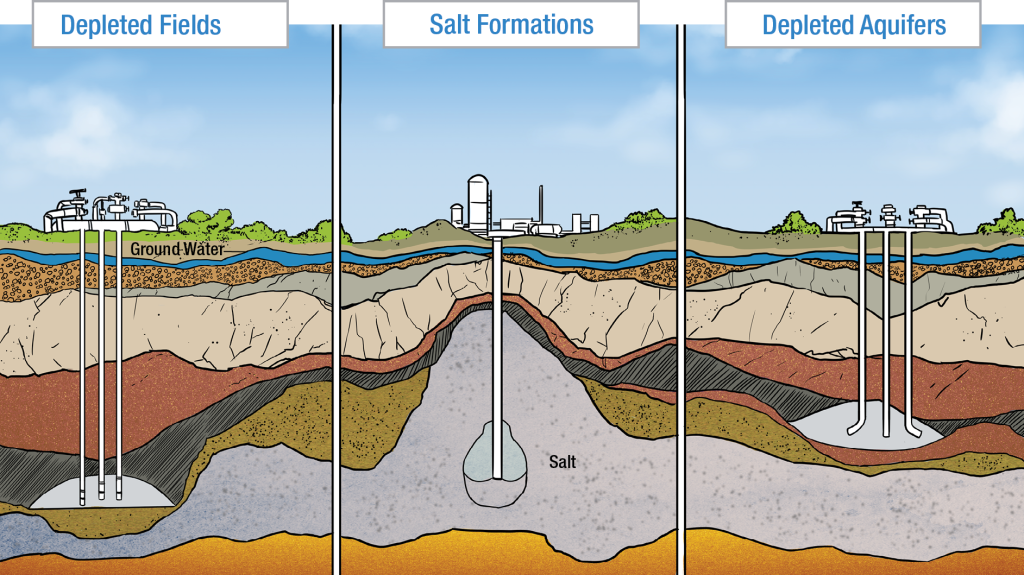The first project of underground gas storage (UGS) was performed in 1915 in Canada and the first project of UGS in the United States was carried out a year later.
The daily average gas consumption in Iran in 4 cold month of the year is 2.5 times that of the remaining 8 month. To tackle the problems of gas supply in cold season’s and in order to secure the flow of gas throughout the country, UGS considered as the best approach to meet the gas peak demands both by the industry and the house hold.
Three main ways of UGS are:
• UGS in the depleted reservoirs
• UGS in water-bearing structures (aquifers)
• UGS in salt structures/salt layers
The most important aims of the UGS are summarized as below:
• Making balance between gas supply and demand in the peak gas demand periods i.e. cold months of the year
• Performance optimization of gas industries as a whole
• Ensuring better negotiating position concerning deliveries of imported gas
• Providing the country with strategic gas reserves by implementation of gas storage plans
• Achieving the objective of maximizing the production from shared reservoirs
Among others, the UGS makes it possible to store much higher volumes of gas under high Pressures and also the smaller amount of land needed for the operation of the UGS. Moreover, the safety and security of the subsurface reservoirs are other advantages of UGS plan.
GEOLOGICAL EVALUATION
The main objective of geological evaluation of a salt formation for the construction of salt cavern is to provide a reasonable level of understanding and delineating data for proper planning, design, construction and finally operation of a salt storage project.
Data provided by different stage of geological evaluation will secure the preparation and development of a more economically feasible and cost effective program by selection of the optimum location, proper cavern design and construction of the salt storage caverns.
A good understanding of the long term environmental impact of the storage operation including project induced subsidence, creep problem, bring disposal and other environmental considerations will be handled with a good knowledge of regional and local geological setting of the salt structure.
It must be born in mind that if a salt structure occurs in a near surface position, it must be treated as a dynamic geologic feature and that it is intimately associated with the nearby strata. A complete analysis and understanding of the complex interaction of rock-salt and its associated surrounding layers will lead to the recognition of the active process within the salt interior. This in turn will result in a more appropriate siting, design and operation of the gas storage project.
SALT FORMATIONS
In general, a salt formation is a mass of rock-salt which can be either in the form of bedded sedimentary formations or upraised instructive salt formations including domes, ridges, etc. Bedded formations which often occur in large basins have relatively thin salt beds of porous or Non-porous impervious layers of other sediments.
SALT STRUCTURE:
By definition salt structure is a structure which results from the upward movement of salt body due to the weight of the overburden and the differential density of salt and the overlying sediments and the elasticity of salt. Rock-salt (halite) displays unique physical properties and mechanical behavior. Rock-salt may occur in two forms; thin bedded and massive. They become massive due to their rheological and deformation mechanism. The massive rock-salts by halo-kinetic movements form salt structure which may be up to 1.6 km in diameter and from 5 to 9 km in height. Dimensions of some salt structure may reach several kilometers.
SALT CAVERN:
Salt cavern are cavities that are artificially created by injection of water into a salt formation. Upon completion, the salt cavern is used for gas/oil storage purposes.
The high solubility of the salt, its mechanical properties and extremely low permeability allows the gas to be contained in salt caverns under high pressures.
Many geological and technical aspect must be taken into consideration when planning underground gas storage in a salt structure. The most important of these are as follows:
• Shape and dimensions of the salt structure
• Depth to salt formation roof
• Mineral composition of salt and non-salt layers
• Geological structure of the salt structure and the likely presence of faulting
• Physical and geo-mechanical properties of salt formation
• Chemical composition of salt and insoluble material content
• Thickness and extent of the salt beds
• Presence and nature/distribution/sickness of non-salt interbeds
• Presence and nature of more soluble evaporate beds

We Answer Your Questions